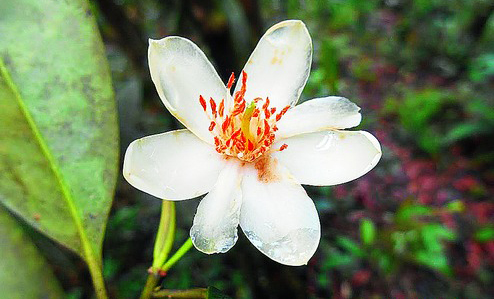
Guwahati, May 30: An endangered tree species, Cleyera grandiflora, has been rediscovered after 80 years in Meghalaya's Khasi Hills by scientists of North Eastern Hill University (Nehu) , Shillong.
The tree was spotted during a two-year survey, carried out across the state during 2014-2016, to locate the species, locally known as Dieng-tiw-la-mluh. The species was last collected from Elephant Falls in Khasi hills by S.R. Sarma in 1935. The present collection is a rediscovery after a lapse of 80 years.
The rediscovery has been reported in the May edition of the journal of The National Academy of Sciences, India. The article has been authored by Aabid Hussain Mir, a research scholar of the department of environmental studies, Nehu, Shillong, Krishna Upadhaya, assistant professor of the basic sciences and social sciences department of the university, and Dilip Kumar Roy, botanical assistant at Botanical Survey of India, Shillong.
Cleyera grandiflora is a medium-sized tree that grows up to 10 metres. The species is found in subtropical broad-leaf forests and grows between elevations of 1,100m and 1,900m.
The plant is of great economic value because of its heavy, fine and hard wood.
"The species is under severe threat and needs to be conserved immediately. We have found that the population of the species is very low and if the threats continues, it will become extinct soon," Mir told The Telegraph.
The study by Mir, Upadhaya and Roy found that the trees leaf out from the first week of May till the end of June and shed leaves from September till November. The period of leaf initiation starts with the onset of rainfall while leaf fall coincides with the dry season. The trees sprout flower buds in March and April and the buds blossom in May and June.
They found that the habitat of the species was getting destructed rapidly, which was severely affecting the population of the species. Repeated human disturbances cause decline of the species and its subsequent extinction.
The study underscored an urgent need to conserve the species from extinction as no initiative has been taken so far. Forest fires, illegal timber extraction and agricultural expansion, which are rapidly contributing to forest degradation and fragmentation, need to be checked in and around the population of this species, it said.
It recommended that the species be brought under in-situ (within natural habitat) and ex-situ (outside natural habitat) conservation programmes for its protection.
The rich flora of Meghalaya was recognised as early as the beginning of the 19th century. Joseph Dalton Hooker, a famous British botanist, who made a huge taxonomic collection for the Kew Herbarium in London from Khasi and Jaintia hills, had remarked that the place was "one of the richest spots in India, perhaps in Asia".










